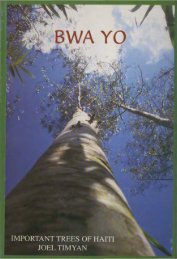Biodiversité - Société Audubon Haiti
Biodiversité - Société Audubon Haiti
Biodiversité - Société Audubon Haiti
You also want an ePaper? Increase the reach of your titles
YUMPU automatically turns print PDFs into web optimized ePapers that Google loves.
60<br />
résultats<br />
Caractéristiques environnementales ou types de végétations<br />
dans lesquelles ont été faites les collectes:<br />
D’une manière générale, les collectes se sont effectuées en<br />
différents points de de Formon, Bois Cavalier, Pic le Ciel et<br />
Plaine Bœuf. Cependant, on a aussi collecté, mais de manière<br />
sporadique, dans des endroits comme Platon moins<br />
sauvages et fortement exploitées par l’homme.<br />
boIs forMond<br />
Il correspond à une forêt très<br />
humide, située entre 900 et<br />
1150 mètres d’altitude et<br />
conduisant à la forêt nébuleuse.<br />
On y rencontre différents<br />
types de végétations, des<br />
zones ouvertes non vierges,<br />
très utilisées pour des activités<br />
agricoles et l’abattage des<br />
arbres à des fins diverses. S’y<br />
trouvent également des formations<br />
secondaires et des vestiges<br />
de la végétation primaire<br />
où l’agriculture fut difficile à<br />
développer.<br />
Dans ces zones de végétations ouvertes et très altérées, on<br />
trouve cependant des individus dispersés de différentes<br />
espèces arborescentes endémiques locales, comme le<br />
« Sapotillier », Micropholis polita subsp. hotteana et Tabebuia<br />
conferta. On y rencontre aussi d’autres espèces endémiques<br />
importantes comme : Manekia urbanii, Eupatorium<br />
hotteanum, Illicium hottensis, Phyllanthus microphylus,<br />
Nesampelos hotteana, Rondeletia formonica et différentes<br />
espèces du genre Mecranium.<br />
Parmis les espèces endémiques, de très intéressantes ont<br />
été relevées dans la végétation en régénération, comme<br />
Ekmaniopappus mikanioides, Elekmania stenodon, Picrasma<br />
antillana, Picramnia sp. Ainsi que différentes espèces<br />
de Miconia. Sur les vestiges de la forêt originelle, poussent<br />
des espèces comme : Bois tremblé, Schefflera tremula, Dendropanax<br />
arboreus, Alchornea latifolia, Haeniantus salicifolium<br />
var. obovatus, et de nombreuses espèces de fougères<br />
épiphytes, d’orchidées et de broméliacées.<br />
boIs cavalIer<br />
Dans cette zone placée entre 900 et 1120 mètres d’altitude,<br />
la végétation est ouverte à la base avec quelques poches<br />
de forêt originelle. La flore de Bois Cavalier est similaire à<br />
celle de Formon ; on y a toutefois relevé la présence d’un<br />
Chimarrhis ekmanii non présent à Formon. Dans les restes<br />
de forêt originelle, les fougères, les mélastomatacées et<br />
quelques espèces d’orchidées sont très abondantes, ainsi<br />
que des arborescents comme : Prunus myrtifolia, Prunus<br />
occidentalis, Dendropanax arboreus, Trichilia havanensis,<br />
Ocotea spp. et Meliosma spp.<br />
results<br />
Characterization of the environments or types of vegetation at<br />
collection sites:<br />
Generally we collected in different areas of Bwa Formon<br />
(Bois Formond), Bwa Cavalier, Pic le Ciel (Pico El Cielo)<br />
and Plaine Beauf. However, we also made sporadic collections<br />
in areas with extensive human impacts, such as Les Platons.<br />
bWa forMon / boIs forMond<br />
This is very humid forest, located<br />
between 900 and 1150m elevation,<br />
reaching Cloud Forest. Here we<br />
found different types of vegetation,<br />
ranging from open areas of high human<br />
impact due to agriculture and<br />
harvest of wood for various uses, to<br />
vegetation in early stages of regeneration,<br />
to advanced second-growth<br />
vegetation with trees up to 10m tall,<br />
to remnants of intact vegetation that<br />
persisted in areas that had been more<br />
difficult to develop agriculturally.<br />
In these highly altered open vegetation<br />
areas there are still widely dispersed<br />
individual trees, among them<br />
some local endemic species such as Micropholis polita subsp.<br />
hotteana y Tabebuia conferta. We also found other important<br />
endemics such as Manekia urbanii, Eupatorium hotteanum,<br />
Illicium hottensis, Phyllanthus microphylus, Nesampelos<br />
hotteana, Rondeletia formonica and several species in the<br />
genus Mecranium.<br />
Among the important endemics collected in regenerating<br />
areas were: Ekmaniopappus mikanioides, Elekmania stenodon,<br />
Picrasma antillana, Picramnia sp. and other species of<br />
Miconia. In the remnant sites of medium to tall original forest<br />
we found species such as Schefflera tremula, Dendropanax<br />
arboreus, Alchornea latifolia, Haeniantus salicifolium var.<br />
obovatus, as well as numerous species of epiphytes, orchids<br />
and bromeliads.<br />
bWa cavalIer<br />
In this area from 900-1200m elevation the vegetation is<br />
mostly open, with some remnants of original vegetation. In<br />
the open areas the flora is very similar to Bwa Formon, but<br />
here we found one individual of a species not found at Formon.<br />
It was Chimarrhis ekmanii, which was left in an area of<br />
minor crops, of principally Ipomoea batatas. In the remnant<br />
original forest, ferns, orchids and species of Melastomatacea<br />
abound. Also some tree species such as Prunus myrtifolia,<br />
Prunus occidentalis, Dendropanax arboreus, Trichilia havanensis,<br />
Ocotea spp. y Meliosma spp.<br />
PIc le cIel<br />
In this formation we found chiefly two kinds of habitats: mixed pine<br />
(Pinus occidentalis) and broadleaf forest, and remnants of broadleaf



